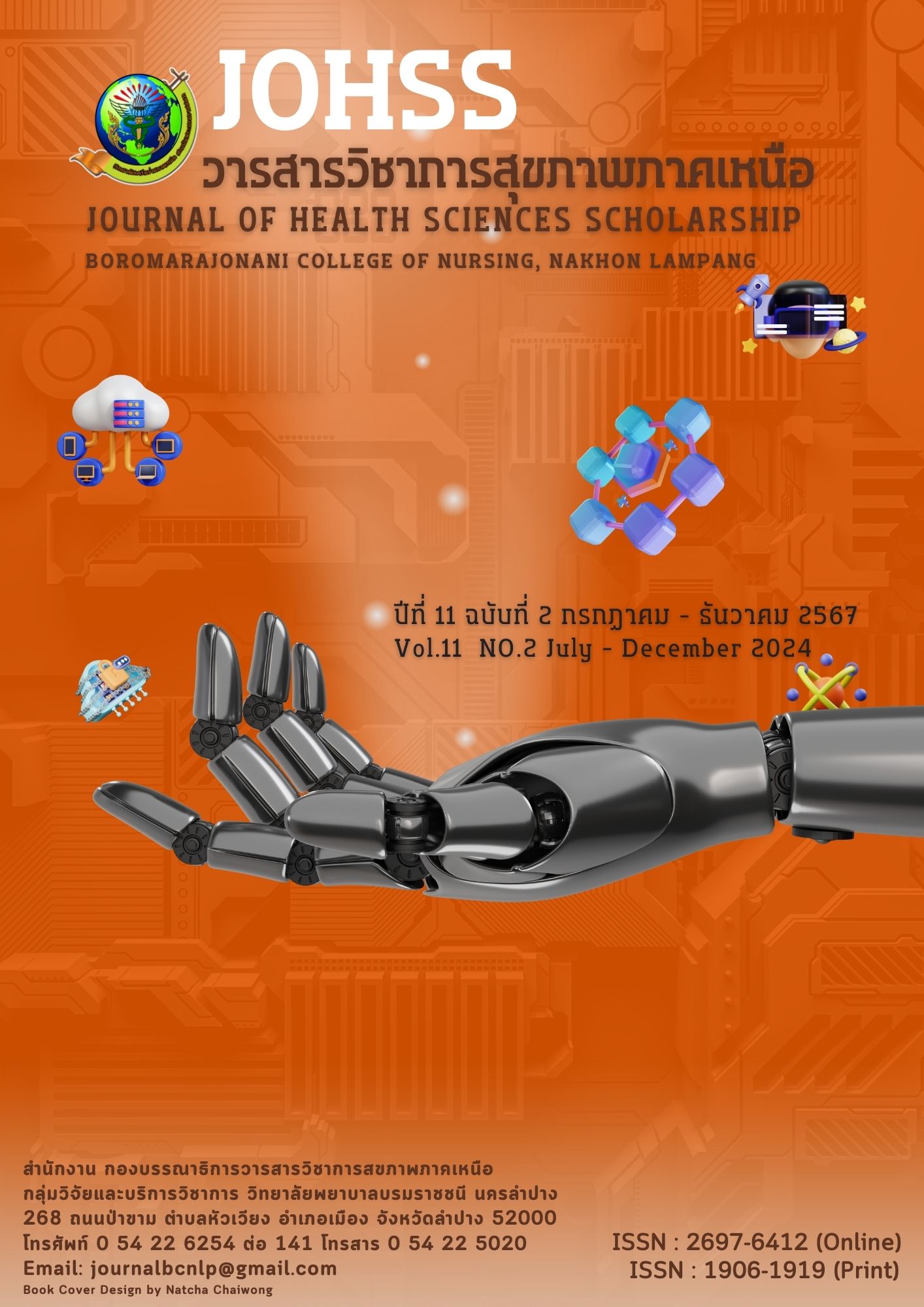ผลของโปรแกรมส่งเสริมการรับรู้สมรรถนะแห่งตนต่อความรู้ การรับรู้ความสามารถ และพฤติกรรมการดูแลตนเองของผู้ป่วยสูงอายุที่ผ่าตัดเปลี่ยนข้อสะโพกเทียม
คำสำคัญ:
การผ่าตัดเปลี่ยนข้อสะโพกเทียม, ความรู้ในการดูแลตนเอง, การรับรู้ความสามารถในการดูแลตนเอง , พฤติกรรมการดูแลตนเอง, โปรแกรมส่งเสริมการรับรู้สมรรถนะแห่งตนบทคัดย่อ
การวิจัยนี้ เป็นการวิจัยกึ่งทดลองแบบกลุ่มเดียววัดผลก่อนและหลัง มีวัตถุประสงค์เพื่อศึกษาผลของโปรแกรมส่งเสริมการรับรู้สมรรถนะแห่งตนต่อความรู้ การรับรู้ความสามารถ และพฤติกรรมการดูแลตนเองของผู้ป่วยสูงอายุที่ผ่าตัดเปลี่ยนข้อสะโพกเทียม กลุ่มตัวอย่างเป็นผู้ป่วยสูงอายุที่เข้ารับการผ่าตัดเปลี่ยนข้อสะโพกเทียม หอผู้ป่วยศัลยกรรมกระดูก โรงพยาบาลลำปาง จำนวน 30 คน เครื่องมือการวิจัย คือ 1) โปรแกรมส่งเสริมการรับรู้สมรรถนะแห่งตน และ 2) เครื่องมือที่ใช้ในเก็บรวบรวมข้อมูลประกอบด้วย 2.1) แบบสัมภาษณ์ข้อมูลส่วนบุคคล 2.2) แบบสัมภาษณ์ความรู้ในการดูแลตนเองหลังผ่าตัดเปลี่ยนข้อสะโพกเทียม 2.3) แบบสัมภาษณ์การรับรู้ความสามารถในการดูแลตนเองหลังผ่าตัดเปลี่ยนข้อสะโพกเทียม 2.4) แบบสัมภาษณ์พฤติกรรมการดูแลตนเองหลังผ่าตัดเปลี่ยนข้อสะโพกเทียม ผ่านการตรวจสอบความตรงตามเนื้อหาค่า IOC ระหว่าง .67 – 1.00 แบบสอบถามความรู้ มีค่าความเชื่อมั่นโดยใช้สูตร K-R 20 เท่ากับ .74 แบบสอบถามการรับรู้ความสามารถตนเอง และแบบสอบถามพฤติกรรมการดูแลตนเอง มีค่าความเชื่อมั่นโดยใช้สูตรสัมประสิทธิ์แอลฟาของครอนบาค เท่ากับ .84 และ .72 ตามลำดับ วิเคราะห์ข้อมูลโดยใช้สถิติเชิงพรรณนาและ สถิติ Wilcoxon signed Ranks Test
ผลการวิจัยพบว่า ภายหลังการใช้โปรแกรมส่งเสริมการรับรู้สมรรถนะแห่งตนในผู้ป่วยสูงอายุที่ผ่าตัดเปลี่ยนข้อสะโพกเทียม กลุ่มตัวอย่างมีค่าคะแนนเฉลี่ยความรู้ในการดูแลตนเอง การรับรู้ความสามารถในการดูแลตนเอง และพฤติกรรมการดูแลตนเอง สูงกว่าก่อนใช้โปรแกรมอย่างมีนัยสำคัญทางสถิติที่ระดับ .001 พยาบาลสามารถใช้แนวทางในการส่งเสริมสมรรถนะแห่งตน เพื่อให้ผู้ป่วยเกิดพฤติกรรมการฟื้นตัวหลังผ่าตัดที่ดี และสามารถกลับไปปฏิบัติกิจวัตรประจำวันได้ใกล้เคียงกับปกติมากที่สุด
เอกสารอ้างอิง
Bandura, A. (1997). Self-efficacy: The exercise of control. W. H. Freeman.
Cohen, J. (1992). Quantitative methods in psychology: A power primer. Psychological Bulletin, 112(1), 155–169.
Chaichalermsak, S., Jitramontree, N., & Leelahakul, V. (2019). Effect of the perceived self-efficacy promoting program on self-care behavior among older patients post laminectomy. Thai Red Cross Nursing Journal, 12(1), 144–160. (in Thai).
Chueybuddha, C., Sripaoraya, S., & Yowson, P. (2019). The effect of self-efficacy promotion program to re-fracture behavior in patients with femoral fractures receiving internal fixation. Krabi Medical Journal, 2(2), 9–16. (in Thai).
Eakwirojanasakul, J. (2019). Refracture prevention in elderly patients with previous hip fracture in Somdejprasangkharach 17th Hospital, Suphanburi. Region 4-5 Medical Journal, 38(1), 39–49. (in Thai).
Gunawan, J., Marzilli, C., & Aungsuroch, Y. (2021). Establishing appropriate sample size for developing and validating a questionnaire in nursing research. Belitung Nursing Journal, 7(5), 356–360.
Inpha, S. (2007). Self-care program for hip replacement patients. (Master’s thesis, Mahidol University). Siriraj Hospital. (in Thai).
Jaipiti, H., & Sasat, S. (2018). The effect of self-efficacy promoting program on fear of fall in postoperative total hip replacement older persons. Journal of The Royal Thai Army Nurses, 19, 109–117. (in Thai).
Jiewprasat, K. (2018). Rehabilitation after surgery for hip fracture in older persons: Challenge issue in nursing. Vajira Nursing Journal, 20(2), 51–65. (in Thai).
Katetanee, R., Sriruecha, C., & Sinsupan, N. (2023). The effectiveness of self-efficacy enhancement program with social support in caring of patients with hip replacement surgery at Maha Sarakham Hospital. Maha Sarakham Hospital Journal, 20(1), 134–150. (in Thai).
Kulwattanapun, P. (2024). Perioperative nurse’s role in taking care of geriatric hip fracture. Siriraj Medical Bulletin, 17(3), 231–236. (in Thai).
Lampang Hospital Medical Records Department. (2022). Statistics of hip fractures in the Orthopedic Department: Lampang. (in Thai).
Menendez-Colino, R., Alarcon, T., Gotor, P., Queipo, R., Ramirez-Martin, R., Otero, A., et al. (2018). Baseline and pre-operative 1-year mortality risk factors in a cohort of 509 hip fracture patients consecutively admitted to a co-managed orthogeriatric unit (FONDA cohort). Injury, 49(3), 656–661.
Poh, K. S., & Lingaraj, K. (2013). Complications and their risk factors following hip fracture surgery. Journal of Orthopaedic Surgery (Hong Kong), 21(2), 154–157.
Polit, D. F., & Gillespie, B. (2009). The use of the intention-to-treat principle in nursing clinical trials. Nursing Research, 58(6), 391–399.
Rattanathammawat, T., & Choowattanapakorn, T. (2018). The effect of the individual and family self-management promoting program on functional capacity among older persons with hip fracture. Journal of Police Nurses, 10(2), 288–297. (in Thai).
Sirited, P., & Thammaseeha, N. (2019). Self-efficacy theory and self-healthcare behavior of the elderly. Journal of The Royal Thai Army Nurses, 20(2), 58–65. (in Thai).
Sripiman, S., Thiangchanya, P., & Purinthrapib, S. (2020). The effects of promoting self-care program to knowledge, self-efficacy, and self-care behaviors of patients with hip surgery at Orthopedics Ward, Songkhla Hospital. Journal of Prachomklao College of Nursing, Phetchaburi Province, 3(2), 149–165. (in Thai).
Suntivorabut, S., Tosakulkao, T., & Leelahaku, V. (2019). The effects of self-efficacy enhancement program on quality of recovery and activities of daily living among post-operative lumbar laminectomy patients. EAU Heritage Journal Science and Technology, 13(3), 159–172. (in Thai).
ดาวน์โหลด
เผยแพร่แล้ว
ฉบับ
ประเภทบทความ
สัญญาอนุญาต
ลิขสิทธิ์ (c) 2024 วิทยาลัยพยาบาลบรมราชชนนี นครลำปาง

อนุญาตภายใต้เงื่อนไข Creative Commons Attribution-NonCommercial-NoDerivatives 4.0 International License.
บทความ ข้อมูล เนื้อหา รูปภาพ ฯลฯ ที่ได้รับการตีพิมพ์ในวารสารวารสารวิชาการสุขภาพภาคเหนือ ถือเป็นลิขสิทธิ์ของวารสารวารสารวิชาการสุขภาพภาคเหนือ หากบุคคลหรือหน่วยงานใดต้องการนำทั้งหมดหรือส่วนหนึ่งส่วนใดไปเผยแพร่ต่อหรือเพื่อกระทำการใดๆ จะต้องได้รับอนุญาตเป็นลายลักอักษรจากวารสารวารสารวิชาการสุขภาพภาคเหนือก่อนเท่านั้น
เนื้อหาและข้อมูลในบทความที่ลงตีพิมพ์ในวารสารวิชาการสุขภาพภาคเหนือถือเป็นข้อคิดเห็นและความรับผิดชอบของผู้เขียนบทความโดยตรงซึ่งกองบรรณาธิการวารสาร ไม่จำเป็นต้องเห็นด้วย หรือร่วมรับผิดชอบใดๆ
อนึ่ง ข้อความและข้อคิดเห็นต่างๆ เป็นของผู้เขียนบทความนั้นๆ ไม่ถือเป็นความเห็นของวารสารฯ และวารสารฯ ไม่จำเป็นต้องเห็นด้วยกับข้อความและข้อคิดเห็นใดๆ ของผู้เขียน วารสารฯ ขอสงวนสิทธิ์ในการพิจารณาตีพิมพ์ตามความเหมาะสม รวมทั้งการตรวจทานแก้ไขหรือขัดเกลาภาษาให้ถูกต้องตามเกณฑ์ที่กำหนด



